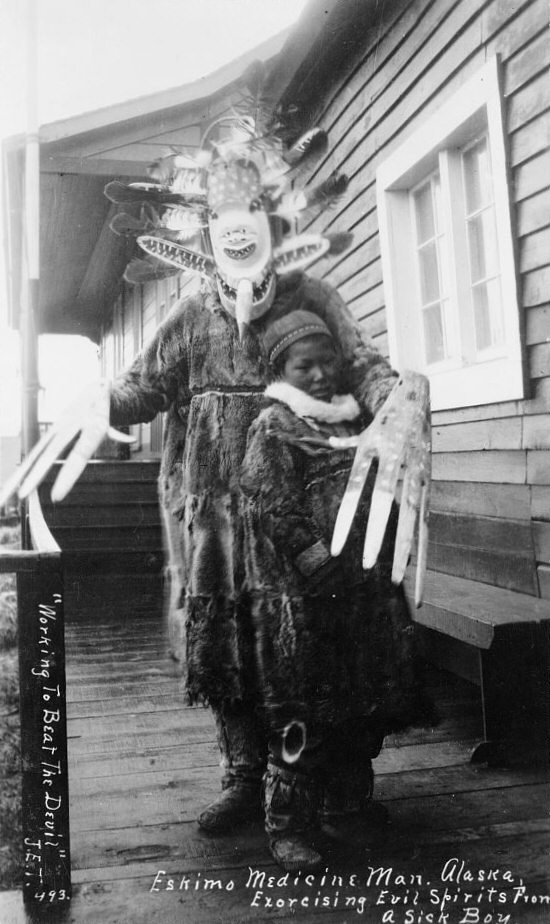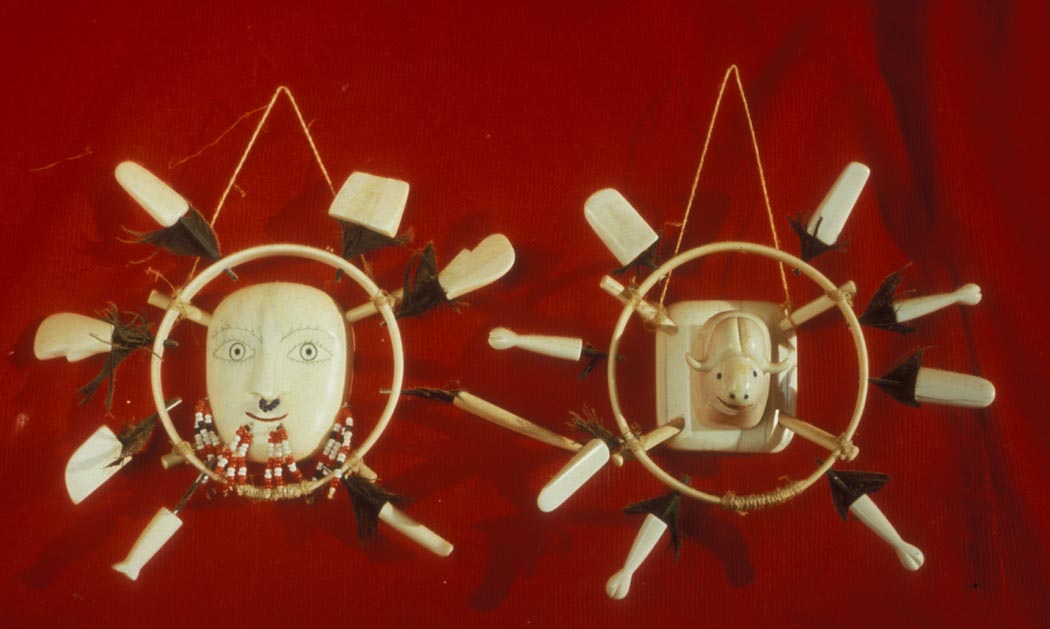Inuit Mask on:
[Wikipedia]
[Google]
[Amazon]
 Masks among Eskimo peoples served a variety of functions. Masks were made out of
Masks among Eskimo peoples served a variety of functions. Masks were made out of
(found on the site o
) of the different communities were often very different. Eskimo groups comprise a huge area stretching from
 Although beliefs about unity between human and animal did not extend to that of absolute interchangeability, several Eskimo peoples had sophisticated soul concepts (including variants of
Although beliefs about unity between human and animal did not extend to that of absolute interchangeability, several Eskimo peoples had sophisticated soul concepts (including variants of
: +4 (= third page after the opening page of the article) Ritual ceremonies could enable the community to enact these stories with the help of masks, sometimes with the masked person representing the animal.
 Masks among Eskimo peoples served a variety of functions. Masks were made out of
Masks among Eskimo peoples served a variety of functions. Masks were made out of driftwood
__NOTOC__
Driftwood is wood that has been washed onto a shore or beach of a sea, lake, or river by the action of winds, tides or waves.
In some waterfront areas, driftwood is a major nuisance. However, the driftwood provides shelter and fo ...
, animal skins, bones and feathers. They were often painted using bright colors. There are archeological miniature maskettes made of walrus ivory
The walrus (''Odobenus rosmarus'') is a large flippered marine mammal with a discontinuous distribution about the North Pole in the Arctic Ocean and subarctic seas of the Northern Hemisphere. The walrus is the only living species in the fami ...
, dating from early Paleo-Eskimo and from early Dorset culture period. Hessel & Hessel 1998: 12–13
Despite some similarities in the cultures of the Eskimo
Eskimo () is an exonym used to refer to two closely related Indigenous peoples: the Inuit (including the Alaska Native Iñupiat, the Greenlandic Inuit, and the Canadian Inuit) and the Yupik peoples, Yupik (or Siberian Yupik, Yuit) of eastern Si ...
peoples, Rasmussen 1965:110 (ch. VIII) Mauss 1979 their cultural diversity makes it hard to generalize how different groups, like the Inuit
Inuit (; iu, ᐃᓄᐃᑦ 'the people', singular: Inuk, , dual: Inuuk, ) are a group of culturally similar indigenous peoples inhabiting the Arctic and subarctic regions of Greenland, Labrador, Quebec, Nunavut, the Northwest Territories ...
and Yupik used masks. The sustenance, Inuit religion, soul concepts, even the languageLawrence Kaplan: Comparative Yupik and Inuit(found on the site o
) of the different communities were often very different. Eskimo groups comprise a huge area stretching from
Siberia
Siberia ( ; rus, Сибирь, r=Sibir', p=sʲɪˈbʲirʲ, a=Ru-Сибирь.ogg) is an extensive geographical region, constituting all of North Asia, from the Ural Mountains in the west to the Pacific Ocean in the east. It has been a part of ...
through Alaska and Northern Canada
Northern Canada, colloquially the North or the Territories, is the vast northernmost region of Canada variously defined by geography and politics. Politically, the term refers to the three Provinces_and_territories_of_Canada#Territories, territor ...
(including Nunatsiavut
Nunatsiavut (; iu, italics=no, ᓄᓇᑦᓯᐊᕗᑦ) is an Autonomous administrative division, autonomous area claimed by the Inuit in Newfoundland and Labrador, Canada. The settlement area includes territory in Labrador extending to the Quebe ...
in Labrador
, nickname = "The Big Land"
, etymology =
, subdivision_type = Country
, subdivision_name = Canada
, subdivision_type1 = Province
, subdivision_name1 ...
and Nunavik
Nunavik (; ; iu, ᓄᓇᕕᒃ) comprises the northern third of the province of Quebec, part of the Nord-du-Québec region and nearly coterminous with Kativik. Covering a land area of north of the 55th parallel, it is the homeland of the I ...
in Quebec
Quebec ( ; )According to the Canadian government, ''Québec'' (with the acute accent) is the official name in Canadian French and ''Quebec'' (without the accent) is the province's official name in Canadian English is one of the thirtee ...
) to Greenland
Greenland ( kl, Kalaallit Nunaat, ; da, Grønland, ) is an island country in North America that is part of the Kingdom of Denmark. It is located between the Arctic and Atlantic oceans, east of the Canadian Arctic Archipelago. Greenland is t ...
. The term ''Eskimo'' has fallen out of favor in Canada and Greenland, where it is considered pejorative
A pejorative or slur is a word or grammatical form expressing a negative or a disrespectful connotation, a low opinion, or a lack of respect toward someone or something. It is also used to express criticism, hostility, or disregard. Sometimes, a ...
and the term ''Inuit'' has become more common. However, ''Eskimo'' is still considered acceptable among Alaska Natives
Alaska Natives (also known as Alaskan Natives, Native Alaskans, Indigenous Alaskans, Aboriginal Alaskans or First Alaskans) are the indigenous peoples of Alaska and include Iñupiat, Yupik, Aleut, Eyak, Tlingit, Haida, Tsimshian, and a numbe ...
of Yupik and Iñupiat (Inuit) heritage, as well as Siberian Yupik
Siberian Yupiks, or Yuits (russian: Юиты), are a Yupik peoples, Yupik people who reside along the coast of the Chukchi Peninsula in the far Russian Far East, northeast of the Russia, Russian Federation and on St. Lawrence Island in Alask ...
peoples, and is preferred over ''Inuit'' as a collective reference.
Early masks
Archaeological masks have been found from early Paleo-Eskimo and from early Dorset culture period. It is believed that these masks served several functions, including being in rituals representing animals in personalized form; Oosten 1997: 90–91 being used byshaman
Shamanism is a religious practice that involves a practitioner (shaman) interacting with what they believe to be a spirit world through altered states of consciousness, such as trance. The goal of this is usually to direct spirits or spiritu ...
( medicine man or ''angakkuq
The Inuit angakkuq (plural: ''angakkuit'', Inuktitut syllabics ᐊᖓᑦᑯᖅ or ᐊᖓᒃᑯᖅ; Inuvialuktun: '; kl, angakkoq, pl. ''angakkut'') is an intellectual and spiritual figure in Inuit culture who corresponds to a medicine man. Oth ...
'') in ceremonies relating to spirits (as in the case of a wooden mask from southwestern Alaska
Alaska ( ; russian: Аляска, Alyaska; ale, Alax̂sxax̂; ; ems, Alas'kaaq; Yup'ik: ''Alaskaq''; tli, Anáaski) is a state located in the Western United States on the northwest extremity of North America. A semi-exclave of the U.S., ...
); it is also suggested that they could be worn during song contest ceremonials.
Associated beliefs
 Although beliefs about unity between human and animal did not extend to that of absolute interchangeability, several Eskimo peoples had sophisticated soul concepts (including variants of
Although beliefs about unity between human and animal did not extend to that of absolute interchangeability, several Eskimo peoples had sophisticated soul concepts (including variants of soul dualism
Soul dualism, also called dualistic pluralism or multiple souls, is a range of beliefs that a person has two or more kinds of souls. In many cases, one of the souls is associated with body functions ("body soul") and the other one can leave the bod ...
) that linked living humans, their ancestors, and their prey. Besides synchronous beliefs, there were also notions of unity between human and animal, and myths about an ancient time when the animal could take on human form at will. Barüske 1969: 7, 9 Traditional ''transformation mask
A transformation mask, also known as an opening mask, is a type of mask used by indigenous people of the Northwest Coast and Alaska in ritual dances. These masks usually depict an outer, animal visage, which the performer can open by pulling a s ...
''s reflected this unity.Thomas 2008: +4 (= third page after the opening page of the article) Ritual ceremonies could enable the community to enact these stories with the help of masks, sometimes with the masked person representing the animal.
Yup'ik masks
The Yup'ik are Eskimos of western Alaska whose masks vary enormously but are characterised by great invention.Yup'ik masks
Yup'ik masks (Yup'ik ''kegginaquq'' sg ''kegginaquk'' dual ''kegginaqut'' pl and ''nepcetaq'' sg ''nepcetat'' pl; in the Lower Yukon dialects ''avangcaq'' sg ''avangcak'' dual ''avangcat'' pl ; in Nunivak Cup'ig dialect ''agayu'') are expre ...
differ in size from forehead and finger 'maskettes', to enormous constructions that dancers need external supports to perform with.The Living Tradition of Yup'ik Masks; Ann Feinup-Riordan; University of Washington Press, Seattle 1996. Many of these masks were used almost as stage props, some of which imbued the dancer with the spirit that they represented - and most were often destroyed after use. Others represented animal people, ''(yuit)'', and insects, berries, plants, ice and objects of everyday life.
See also
*Inuit art
Inuit art, also known as Eskimo art, refers to artwork produced by Inuit, that is, the people of the Arctic previously known as Eskimos, a term that is now often considered offensive. Historically, their preferred medium was walrus ivory, but s ...
References
Further reading
* The tale title means: "The way life appeared"; the book title means: "Eskimo tales"; the series means: "The tales of world literature". * * * * * * * * Hungarian translation of Rasmussen 1926. * * Translation of the original:External links
* {{DEFAULTSORT:Masks Among Eskimo PeoplesEskimo
Eskimo () is an exonym used to refer to two closely related Indigenous peoples: the Inuit (including the Alaska Native Iñupiat, the Greenlandic Inuit, and the Canadian Inuit) and the Yupik peoples, Yupik (or Siberian Yupik, Yuit) of eastern Si ...
Eskimos
Inuit culture
Inuit art
Inuit shamanism
Indigenous woodcarving of the Americas
Masks in the Americas